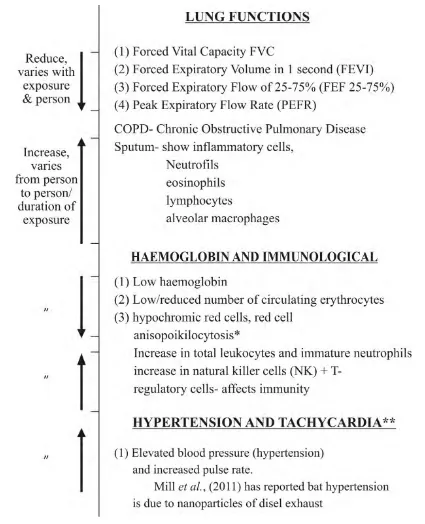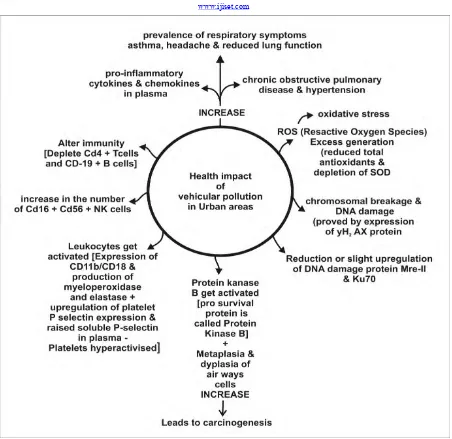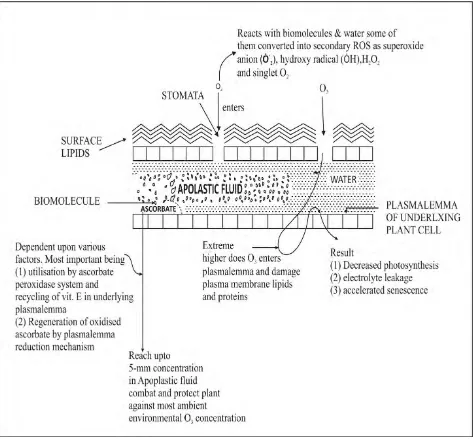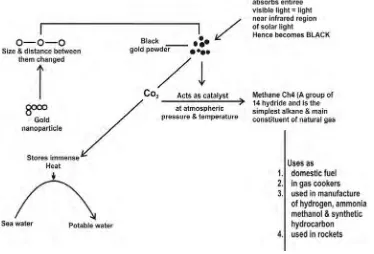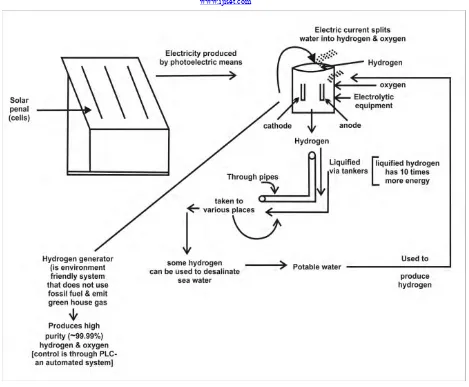111
Curse of Air Pollution & Mitigation
Strategies
Umapati Sahay¹ & Kumari SmitaP
2
P
1
P
Former University Professor, HOD, P.G, Department of Zoology, Ranchi University, Ranchi. Jharkhand
P
2
P
Asstt. Professor, Department of Botany, J.N.College, Dhurwa, Ranchi University, Ranchi, Jharkhand
Abstract: According to American Medical Association air pollution has been defined as “The excessive concentration of foreign matter in the air which adversely affects the well being of individuals or cause damage to property”. However other definitions have also been forwarded. In recent time the natural world is facing great degradation so far our environment is concerned. The toxic emissions , waste ,dust, smoke, soot & many others have created year round problem in many of the urban and rural areas though it shows periodic spike specially in winter yet this is also a fact that Indo-gangetic belt record poor air quality levels across the year. Air pollution was responsible for 12.5% deaths in 2017 as per Indian state level Burden Assessment whereas WHO reported 1,00,000 deaths of infants annually due to air pollution in India. It affects elders as well as those who are in wombs, newborns too. Pollution could be natural or manmade with the technological and industrial advancement a wide range of changes in environment have come into effect. Burning of fossil fuel enhanced the carbon cycle by 20%, nitrogen cycle by 30-40% and sulphur cycle by 70 to 80%. Forest clearing in III world countries has resulted in 3.3 billion tons of carbon & conversion of only 50% of the existing tropical forest would release about 550 billion tons of COR2R of which 40% would remain in the atmosphere increasing its COR2R content by 15%. Release from live and dead biomass will be in addition. High concentration of COR2R in atmosphere has a consequential effect. Along with this ambient, air pollution is also due to particulate matters (PM), volatile organic compounds (VOCs) like benzene, toluene, ethyl benzene, xylene (BTEX), poly aromatic hydrocarbons (PAHs) and inorganic pollutants like NORxR, SOR2R OR3R etc. All these along with other pollutants cause many types of disease in human beings such as asthma, reduced lung function, chronic obstructive pulmonary disease, increase in pro-inflammatory cytokine, altered immunity, excessive generation of reactive oxygen species and depletion of superoxide dismutase (SOD) leading to oxidative stress. Not only this, increased chromosomal breakage and DNA damage with insufficient DNA repair, triggering of carcinogenesis have been reported. All these have been discussed. Not only these, OR3 R(ozone) toxicity in plants due to entrance of ozone via stomata into apoplast is of particular interest & how the plants protect themselves have been discussed. Mitigation strategies have also been critically analysed.
112
INTRODUCTION
Air pollution has now become common in all cosmopolitan cities, especially in Delhi, Chennai, Kolkata, Kanpur etc and adjoining areas. It has penetrated in rural pockets also.
The major cause of air pollution is burning of fossil fuel in factories and homes. The pollution is also due to burning of crop residues in agricultural fields, emission from vehicles large and small.
The air gets loaded with COR2R, SOR2R, various nitrogen oxides (NO, NOR2R, NOR3R), dust, smoke, heat, water vapour.
During night COR2R is released in the air but is a natural component of atmosphere. On the one hand COR2R creates a blanket over the atmosphere which does not permit ‘outgoing’ of long wave solar radiation.
Though there are natural sink’s of COR2R (like ocean and water bodies), various plants (during photosynthesis) but if the magnitude of emission through various ways exceeds the natural sinks, it heats up the earth (global warming) and has health hazards too.
According to Schneider (1975) a doubling of COR2R [pre industrial atmospheric partial pressure of COR2 Restimated at 293 ppm] to about 600 ppm may increase the atmospheric temperature by 1.5º Celsius to 3ºCelsius where as other estimated this doubling to be 2º Celsius.
SOR2R leads to the formation of HR2RSOR4R sulphuric acid which is highly corrosive similarly oxides of nitrogen besides having a lot of health hazards, turn to HNOR3R (Nitric acid) which is also highly corrosive. It reacts with salts (NaCl) & form HCl (hydrochloric acid).
Stratospheric ozone protects earth from ultra-violet radiation yet aerosol spray cans, air conditioners & refrigerators, foam plastic release chlorofluorocarbon (CFC) gas which enters troposphere and destroys the ozone layer. Nitrogen oxides released from exhausts & from large fleet of supersonic aircraft at height of 15000 m, atoms of oxygen, hydrogen & various combinations of H&O + chlorine atoms too inflict ozone layer.
Depletion of ozone not only causes skin cancer, possibly it weakens the absorbing capacity of UV solar rays by the earth leading to increase in temperature.
Polluting agents are too many which increase or decrease with season, operating times of factories power generators, automobiles, space heating and agriculture practices.
The present article is compiled from different sources, research papers and throws light on pollution effects on human health and mitigation strategies which could be adopted.
MATERIAL & METHODS
113
OBSERVATIONS & DISCUSSION
Following are the adverse effect of air pollution on human health depending upon the person’s immunity time of exposure and place where he resides.
Table 1- Changes in health related functions
*Variation in size & abnormal shape of red blood cells- indicative of various anemias. ** Abnormally rapid heart rate usually 160-190 p/m
114
● Disc shaped structure in blood-help in blood coagulation * Structural protein found in skin and connective tissue
** A heterodimer protein complex consisting of CD 11 b and CD 18 -helps in adhesion related association between monocyte, macrophage NK cells and granulocytes. ● ● An enzyme encoded by Mpo gene on chromosome 17 in humans
*** Immunoglobulin IgG formed in response to cardiolipin (is a phospholipid -a kind of fat)
115
● Mn- micronucleus
116
*Bronchitis - increased mucus and inflammation
**Emphysema - Destruction and enlargement of air spaces
117
MAJOR POLLUTANTS OF AIR
The major pollutants CO, NORxR, SOR2R, OR3R and some organic compounds like VOCP ●
P
are culprit of health hazards. Out of these:-
1. CO & COR2R come from power and industrial sectors which are major sources of emission. Though COR2R concentration is important for photosynthesis & stomatal opening & carbon & water metabolism yet is the major cause of global warming & subsequential effects on climate change is not good for health.
2. SOR2R - is emitted from fossil fuel burning, smelting from thermal power plants, vehicular emission and volcanic eruptions. Though plants absorb SOR2R via stomata which subsequentially get incorporated into cestine & other compounds through sulphur cycle yet harm the plants in photosynthesis & stomatal opening. Humans are suffocated and are the major cause of cell death.
3. OR3R - Its origin is associated to precursor gases (NORxR & VOC) and solar radiation. Its generation is linked to stratosphere- troposphere exchange process or downwind transport from the source, Agarwal et al. (2016). In urban areas O₃ is limited by VOC but in rural pockets O₃ is limited to NORxR (Sukla et al. 2017). Inhalation of O₃ by plants and animals has been discussed separately.
4. VOC – The major source of VOC, are individual emission, fuel refining, vehicle emission & burning of fossil fuels (Cape, 2003; Singh et al. 2017b). Plants are sensitive to VOC (Cape, 2003) so are the animals.
5. Particulate matters- It is comprised of liquid and solid particles suspended in the air (Kumar et al. 2015b, 2016). Originating from different sources particulates are linked to have diverse effects on health of plants as well as animal & humans.
U
COUR2RU (Carbon dioxide) –
COR2 Ris released in the atmosphere by burning of fossil fuel (Coal, Oil etc). Fossil fuel releases 18 x 10P
12
P
tonnes of COR2R each year. Thermal power plants release around 50 million tonnes of COR2R each year Sharma (1998) mentioned that annual consumptions for super thermal power plants are:
Singrauli - 8 million tonnes Korba - 5 million tonnes Ramagundam - 8.5 million tonnes Farakka (high grade) - 5 million tonnes
Higher concentration of COR2R in troposphere becomes a serious air pollutant as it forms a thick layer above and prevents the heat from being re radiated. It acts like a glass panel of green house. It allows sunlight to filter through but prevents the heat from being re radiated in the outer space. This is called “green house effect”.
P
●
P
118
Most of heat absorbed by COR2R and water vapour in the atmosphere, adds to the heat already present, thus this heats up the earth surface.
Deforestation leads to decrease in the consumption of COR2R by plants and retardation in cycling. This too adds COR2 Rin atmosphere.
Plant take in COR2R for photosynthesis on decay of plants & animals, carbon is released in the soil. Bacterial action and through respiration of plants & animals, carbon is released in the atmosphere.
It is true that atmospheric COR2R is absorbed by ocean and water bodies acting as carbon sinks yet if these get saturated by COR2R - the outcome will be more COR2R in the atmosphere (exp. Absorption of COR2R by North Atlantic Ocean plunged by ½ between mid 1990’s- reported by Ute Schuster 2007.
119
Consequences of COR2R & other gaseous accumulation in the Atmosphere
Air pollution reduces the power generation capacity of solar panels differently in different areas for example:
a. 12% in Delhi (per year ) during 2016-17 – the total sun light reaching the grounds reduced by more than 9P
th
P
– this corresponds to 40 kwh/m₂ (kilowatt hours per square metre) of energy generation every year for a 20% efficient silicon solar panel
b. 2% in Singapore,
c. 9% in Beijing, Dhaka, Ulan Bator and Kolkata,
12% reduction in Delhi is “Larger than profit margin for some solar installation and literally enough to make the difference between or successful project and on that fails”- Ian Merius Peter, (MIT. Cambridge Massachusetts).
Total revenue loss estimated was: (a) 16 million for Kolkata
(b) 10 million for Beijing (c) 10 million for Sanghai
(d) 6 million for Los Angeles- Shristi Chowdhury, 2018.
120
Fig. Effect of vehicular pollution
Ozone versus Plants
Ozone (OR3R), one of the potential environmental surface oxidant, once enters a plant through leaf stomata reach apoplastic fluid and can enter plant cell via plasmalemma provided it is in its extreme dose, thus damage the plasma membrane lipids & protein. OR3R is capable of reacting with bio molecules of apoplast and some of it is converted to secondary ROS like super oxide onion radicals (O·R2R-), hydroxyl radical (O·H), HR2ROR2R and singlet oxyge – Hoigne et al. (1975) and Kenofsky et al. (1995); Koppenol (1982); Grime et al. (1983); Byvoet et al. (1995).
The extreme dose of OR3 Rleads to oxidative stress and thereby inflicts an assault leading to:
121
3) Accelerated senescence – Schraudner et al. (1996); Sandermann (1996)
Ascorbate of Apoplastic fluid combat and protect plant against most ambient environmental OR3R concentration which is dependent upon so many factors, most important being:-
(1) Utilisation of OR3R by acrobate peroxidase system and recycling of Vit E in underlying plasmalemma.
(2) Regeneration of oxidised ascrobate by plasma lemma reductive mechanism.
122
Extremely high doses (much higher than usual air pollution level) of OR3R permeates to plasmalemma proteins & lipids. Although ascorbate protects the plants against OR3R injury yet mutants deficient in ascorbate metabolism pathway are sensitive to OR3R - Conklin et al (1997).
Exposure to acute tropospheric OR3R levels leads to visible injury opines Vollenweider et al. (2005).
Ozone versus inflammation (human system)
Tropospheric Ozone (a ubiquitous urban pollutant) has a number of adverse effect- Ostro et al. (2006), Vaggaggini et al. (2002) including premature mortality, respiratory disease, asthma attacks etc.
In humans, inhalation of ozone in amounts as low as 0.1 to 0.2 ppm is sufficient to cause toxicity characterised by edema, airways hyper responsiveness, alveolar epithelial damage & impaired host defence – Lippman (1989).
When pollutants + deleterious airborne substances enter airways, an inflammatory stimulus is created as a result of which airways start recruiting inflammatory cells like T&B lymphocytes, neutrophils, basophils, eosinophils.
Out of these, basophils produce 1L-6 cytokine which increase in due course of time. This increase, results into mucus secretion and formation of reactive oxygen as well as nitrogen species (ROS/RNS). Not only this, 1L-6 promotes recruitment of T&B lymphocytes. In the bronchial & tracheal epithelial cell, inflammatory stimulus activates iNOS (inducible nitric oxide synthase) also which produce ROS/RNS like HR2ROR2R where as cytokines stimulate the production of NO.
124
Fig.: Regulation of the expression of inflammation associated genes
Transcription factors NF-kB and APR1R are regulated by redox state of the cell –Muller et al. (1997).
Nuclear translocation and subsequent binding to DNA of the NF-kB complex occurs in response to HR2ROR2R (hypochlorus acid) and multiple cytokines- Baldwin (1996). , Schoonbroodt (1997). Once in the nucleus these dimers bind a consensus sequence found in promoter region of many genes such as 1L-6, 1L-8, 1L-1 and TNF-α.
Activation of NF-kB has been observed in inflammatory cells from patients with airways disease.
TNF-α induced activation of AP₁ (oppose the NF-kB) is increased by exposure to antioxidants (like pyrroline dithiocarbamate PDTC) – Martin et al. 1998.
NF-kB transcription factor exists in the cytoplasm in an inactive complex bound to I-kB (an inhibitory subunits). ROS is supposed to regulate phosphorylation of I-I-kB. Once phosphorylation is complete, NF-kB is released to be translocated into the nucleus.
GSHPRx R(Glutathione peroxidise) is an enzyme, which when over expressed reduces translocation of (a) NF-kB, and (b) reduced phosphorylation of I-kB in response to oxidative stress or TNF-α exposure.
125
Absorption of NOR2R by plants
Vallano et al. (2007), Takahashi et al. (2003) and Segshneider et al. (1995) opine that plants take up atmospheric NOR2R and pass on to different pools of nitrogen within the plants there using NOR2R as an alternative fertiliser. The intake of NOR2R is via leaf (and root) surface. The stomatal opening conveys it to apoplast- Welburn (1990) where it (NORxR) is metabolised to organic amino acid via nitrate assimilation pathway. Thus NOR2R act as a nutrient.
NORxR is pumped into the environment via automobile exhaust or from places wherever fossil fuel is burnt. NORxR means oxides of nitrogen such as NO (nitric oxide), NO₂ (nitrogen dioxide). In plants NO₂ deposits on leaf surface as such NO₂ levels is supposed to be an overall indicator of atmospheric NORx Rstatus.
NO₂ has a role in the ozone generating photochemical oxidant cycle and is – of most concern to human health.
126
U
COPD/Asthma/ARDS etc
A. It is the respiratory system which suffers the most in urban areas compared remote rural pockets. People suffer from Asthma, Chronic bronchitis, chronic obstructive pulmonary disease (COPD), cystic fibrosis, acute respiratory distress syndrome (ARDS).
Asthma- It has been observed that in the epithelial cells from Asthamatics in BAL fluid 1L-6 mRNA increase- Marini et al. (1992).
COPD- Keating et al. (1996) found increase of 1L-8 level in sputum of the patient suffering from COPD (Chronic obstructive pulmonary disease) - blocks the air flow and make it difficult to breadth due to Emphysema and chronic bronchitis. In Emphysema the air spaces are destructed or enlarged.
127
Debts et al. (1989), Damas et al. (1989) and Dinarello et al. (1993) observed in ARDS that neutrophils get activated and release cytokine like TNF-α, IL-b and IL-8 where alone or in combination increase inflammatory responses.
Asthma, chronic bronchitis COPD and ARDS increase adhesion molecules (I-CAM-1) in inter cellular spaces –Engelberts et al. (1992), Riise et al. (1994).
I-CAM-1 though can be inhibited by Dimethylthiourea (DMTU) & PDTC (Pyrrolidine dithiocarbamate) but helps in adhesion of inflammatory cells to remain in Airways, it’s over production permits more inflammatory cells to remain in Airways for longer period. At the same time I-CAM-1 (adhesion molecules) promotes immunologic and inflammatory reactions in leukocytic diapedesis.
In diapedesis, leukocyte squeezes through capillary walls to enter tissue space outside the blood vessel.
Mitigation Strategies to Curb Air Pollution
1) Awareness :
Life in cosmopolitan cities has become a hell due to Air pollution. India has 14 of the 15 cities in the world with the most air pollution. In 2018, PM- 2.5 levels were poor, very poor or severe 56% in Delhi (R.K.Puram), 49% in Patna and 32% in Kanpur. In between two extremes these places showed a little variation i.e, good condition for a few days but the outcome of pollution remained grave.
More or less similar situations were observed in Kanpur, Kolkata- the most populated cities.
Knowing well that pollution creates a lot of health hazards no concrete steps have been taken. It is our duty to communicate the pollution scenario to those who are unaware of it- Rural mass, uneducated people, woman and children. Environmental awareness programme should not be restricted to urban schools and colleges, Planners, thinkers, scientists, politicians who work in air conditioned chamber and are far away from the reality should take immediate steps to curb the nuisance of pollution at war footing.
128
Fig.: Plants as efficient particle collectors
The best strategy to curb particulate matter from the atmosphere includes PLANTATION of suitable trees along roadside in urban areas. Dochinger (1973) opines that filtering effects of ever green trees are better than deciduous trees which can reduce 25% PM if planted in single row. Priority should be given to trees which are:
a. readily propagable b. requires less maintenance
c. Pest/disease resistant- Kumar et al. (2013). Ingold (1971) opines that the plants with leaves with complex shapes and large circumference collect particles more efficiently. Kumar et al. (2013) suggested that plants plantation should be done after viewing the Agro- climatic suitability.
Plants which are heavy pollen emitters and bearing large fruits should be avoided as far as practicable because pollen may cause allergic manifestations in human beings.
Drought proofing under MANREGA [Mahatma Gandhi National Rural Employment Guarantee Scheme] - a wage based social protection programme is an effort in this direction.Draught proofing involves:
1. Plantation of suitable trees which benifits communities and local ecosystem, a poverty based agenda,
2. Corporate afforestation for the benefit of industrial needs.
129
3) Black Gold Particles:
Dr. Vivek Polshettiwar Associate Professor Dept. of Chemical Sciences TIFR (Tata Institute of Fundamental Research) with his colleagues claims to have created a nano sized black gold powder by changing the size of gold nanoparticles and distance between them, causing them to absorb the entire visible and near infrared region of solar light and turn black.
These black gold powder acts as a catalyst to convert COR2R to methane at atmospheric pressure and temperature. Possibly these particles can be used to reduce COR2R concentration formed by industrial units and vehicular emissions- claimed the author.
The authors claimed that these particles can be used to convert sea water into portable water using the heat it absorbs from the sun.
Methane is a core component of compressed natural gas and is used to power vehicles.
Absorbing COR2R and producing methane by gold particles is significant contribution by the team, however we have to see how much it is cost effective- reports Snehal Fernandes (2019).
Fig. Diagrammatic representation of conversion of gold nano particles to black gold powder Question- cost effectiveness to be judged
4) Epoxide:
It has been suggested by Michal North et al. (New Castle University, Organic Chemistry division) that conversion of COR2R into cyclic carbonate with the help of epoxide – a catalyst (derived from aluminium) at room temperature and atmospheric pressure, can minimize the atmospheric COR2R load.
130
Fig.- Conversion of COR2R into cyclic carbonate
5) SOLAR HYDROGEN TECHNOLOGY:
According to Sheer (2000) solar power has three characteristics: 1. Infinite availability – (approximately 5 billion years,
2. Its transformation into secondary energy and secondary materials (heat, fuel, electricity) give rise to “NO EMISSION”,
3. Solar sources are wholly or partially everywhere. It is to be extracted in a decentralised and regional manner. Sheer (2000)- remarked “The non-infinite nature of solar resources will finally enable a lasting civilisation to unfold”.
Sun cannot be privatised. Solar hydrogen technology – Bolkow (1997) suggested its use as it is a complete closed system of energy production, the advantages of this technology is a great deal of water production which evaporates in the air and no waste material is produced. Other established energy system produce biproducts which are poisonous but always involve chemical or isotopic changes and these are dumped in water, ground and other places. In this technology Solar cells are installed at suitable places. The electricity produced by photoelectric means, is converted into hydrogen using electrolytic equipment. Hydrogen and electricity then could be used to develop agriculture and for industrial purposes.
131
Fig. - Production of Hydrogen
6) Checking human population:
The current population of India is 1,369,819,203 as of Tuesday July 30, 2019 based on the latest United Nations estimates. India population is equivalent to 17.74% of the total world population.
The population density in India is 460 per KM² (1,192 people per mi²), urban population being 33.6% (about 460,249,853).
The causes involved in the population growth are fertility, mortality and migration. The rate of growth is primarily determined by the relation between birth and death rates.
If a woman bears average two children the world population by 2050 will go to 9.4 billion but if the average is 2.5 children it would be 11.2 billion and it will grow indefinitely passing 27 billion by 2150- Sahay and Singh (2018).
A check is needed. The author feel that young generation needs proper education so that they learn the consequential effect on long run.
132
In India there are 14-15 cities with most air pollution. They attain dangerous level during Dipawali or after harvesting. The lungs and brain of children (in terms of percentage) are being irreversibly damaged. Shankar (2018) has therefore suggested certain measures to be taken. These are:
i. Get all households to use clean energy for cooking with liquefied petroleum gas (LPG), or electricity. Ujwala is an effort in this direction.
ii. Burning of cow dung cakes and firewood for cooking is stopped as it harms eyes and lung and is the major cause of air pollution.
iii. He advocated for a suitable subsidy from the government or cross subsidy by Energy Company towards electricity or gas.
iv. In order to stop crop burning in the field, Shankar suggested that, government should buy the crop residue for conversion into briquettes. The thermal plants should offer suitable price for briquettes.
v. Scrapping of old cars/trucks in a phase wise manner. These needs, lowering the price of new vehicles on which the government should forgo substantial portion of GST. He advocated for electric vehicles- this needs sufficient number of charging stations. Government has already taken steps in this direction.
vi. Old coal fired stations be closed immediately.
vii. Industrial clusters need “a diagnostic audit” for air pollution. He suggested for technically feasible measures with state financial assistance and in partnership with industrial units.
133
CONCLUSION
Pollutants are too many; each one has been described in text. Co-operation of public, politicians, scientists, educationists, & leaders of all world countries are required. An effort should be made whole heartedly.
REFERENCES
1. Agarwal, Prerita; Mangaldeep Sarkar; Binayak Chakravorty and Tirthankar Banarjee. 2018.Phytomanagement of Polluted Sites. Research Gate Chapter 7:221-240. 2. Baldwin, A.S.Jr.1996. The NF-kB and I-kB proteins : new discoveries and insights. Ann
Rev.Immunol.14:649-683.
3. Balkow Ludwing.1999. A man with vision. Scala.11.41 pp.
4. Byvoet, P.; J.U.Balis; S.A.shelkey; M.R.Montogomery and M.J.Barber. 1995. Detection of hydroxyl radicals upon interaction of ozone with aqueous media or extra cellular surfactant: the role of tracer iron. Arch. Biochem Biophys.319:464-469.
5. Cape, J.N.2003. Effects of airborne volatile organic compounds on plants. Environ.Pollut. 122:145-157
6. Chee, T.Y and S. Ridwan. 1984. Fast growing species of trees suitable for urban road side and shade planting. MalaysianFor. 47:263-284.
7. Choudhury Srishti. 2018. Mint Aug 18/2018
8. Conklin, P.L.; J.E.Pallanca; R.L.Last and N.Smirnoff. 1997. L-Ascorbic acid metabolism in the ascorbate deficient Arabidopis mutant vtel. Plant Physiol.115: 1277-1285.
9. Debets,P.; A.Reuter; P.Gysen; J.Demonty; M.Lamy & P.Franchimont. 1989. Tumour necrosis factor & interleukin-1 serum levels during severe sepsis in humans. Crit.care.Med.17:975-978.
10.Dinarello,C.; J.Gelfand and S.M.Wolff. 1993. Anticytokine strategies in the treatment of the systemic inflammatory response syndrome. JAMA.269:1829-1835.
11.Dochinger. L.S.1973. Miscellaneous publication no.1230. USDA, Forest Service upper Darby pp.22.
12.Engelberts, I.; S.Samyo; J.F.Leeuwenberg; Van der Linden C.J & W.A.Buurman. 1992. A role for ELAM-1 in the pathogenesis of MOF during septic shock. J.Surg.Res. 53:136-144.
13.Fernandis, Snehal. 2019. TIFR creates nano sized black gold powder to fight COR2R - H.T.Ranchi dt July 2019.
14.Grimes, H.D.; K.K.Perkins and W.F.Boss. 1983. Ozone degrades into hydroxyl radical under physiological conditions. Plant Physiol.72:1016-1020.
15.Hoingne, J. & H. Bader. 1975. Ozonation of water: role of hydroxyl radicals as ozonizing intermediates. Science. 190:782-784.
16.Jha, Abhishek. 2018. Air pollution goes national as PM 2.5 spreads to states. H.T.Ranchi dt.30.12.2018.
134
18.Keatings, V.M.; P.D.Collins; D.MScott and P.J.Barnes. 1996. Differences in interleukin-8 and tumor necrosis factor-α in induced spectrum from patients with chronic obstructive pulmonary disease or asthma. Am.J.Respir.crit.care-Med.153:530-543. 19.Koppenol, W.H. 1982. The reduction potential of the couple O₃/O·P
-P
₃, consequences for mechanisms of ozone toxicity. FEBS Lett. 140:169-172.
20.Kumar, M.; S.Tewari; V.Murari; A.K.Singh & T.Banerjee. 2015b. Wintertime characteristics of aerosols at middle Indo-Gangetic plain: impacts of regional meterology and long range transport. Atmos.Environ. 104:162-175.
21.Kumar, S.Ramesh; T.Arumugam; C.R.Ananda Kumar; S.Balakrishnan and D.S.Rajavel. 2012. Use of plant species in Controlling Environmental pollution- A review. Bull Environ Pharmacology and Life Sciences.2(2):52-63.
22.Kumar,M.; R.K.Singh; V.Murari; A.K.Singh; R.S.Singh and T.Banerjee. 2016. Fireworks induced particle pollution: a spatio temporal analysis. Atmos.Res. 180:78-91. 23.Lavnikova, N.; S.Prokhorova; A.Lakhotia; R.Gordon and D.L.Laskin. 1998.
Distinet inflammatory responses of adherent rat lung vascular neutrophils to pulmonary irritants. J.Inflamm. 48:56-66.
24.Lippman, M.1989. Health effects of ozone. A critical review. J.Air.Pollut Control Assoc.39:672-695.
25.Maheshwari, J.K. 1963. The flora of Delhi council of Scientific & Industrial Research, New Delhi.
26.Marini, M.; E.Vittori, J.Hollemborg and S.Mattoli. 1992. Expression of the potent- inflammatory cytokine, granulocyte- macrophage-colony-stimulating factor and interleukin-6 and interleukin-8 in bronchial epithelial cells of patients with asthma. J.Allergy.clin.Immunol. 89: 1001-1009.
27.Martin Linda D.; Thomas M.Krunkosky; Judith A.Voynow and Kenneth B.Adler.1998. The Role of Reactive Oxygen and Nitrogen Species in Airway Epithelial Gene Expression. Enviromental Health Prespectives. 106:1197-1203.
28.Muller, J.M. , R.A.Rupee and P.A. Baeuerle.1997. Study of gene regulation by NF-kB and AP-I in response to reactive oxygen intermediates. Methods (Orlando).11:301-312. 29.Nandi, Jayshree. 2018. What Indian states must do to curb air pollution? H.T.Ranchi dt
01.11.2018.
30.North Michael et al. 2008. Not available in original.
31.Oommanchan, M.1977. The flora of Bhopal (Angiosperm) K.Jani Brothers, Bhopal. 32.Ostro, B.D.; H.Tran and J.I.Levy. 2006. The health benefits of reduced tropospheric
ozone in California. J.Air Waste Manag Assoc.56:1007-1021
33.Pandey, Jyoti. 2018. Air Pollution: Reactive brand aid solutions will not solve the problem. H.T.Ranchi dt.2.11.18.
34.Pendino, K.J. , J.D.Laksmi,1993. Enhanced production of nitric oxide by rat alveolar macrophage following inhalation of a pulmonary irritant is associated with increased expression of nitric oxide synthase. J.Immunol.151: 7196-7205.
35.Pokhhriyal, T.C and B.K.Subha Rao. 1986. Role of forest in mitigating air pollution. Indian For. 112:573-582.
135
37.Riise, G.C.; S.Larsson; C.G.Lotdahl and A.anderson. 1994. Circulating cell adhesion molecule in bronchial lavage and serum in COPD patients with chronic bronchitis. Eur.Respir.J.7:1673-1677.
38.Sahay Umapati.; R.P.Singh and Anita Jha. 2009. Global Warming- Its consequences and remedial measures. Biospectra. 4(2):211-222
39.Sahay Umapati; M.T.Dan; Hem Srivastava; H.C.P.Sah and Anita Jha. 2006. Impact of environmental degradation versus human population. In Industrial pollution and its management Edil. P.C.Trivedi. Avishkar Publishers & Distributors Jaipur, Rajasthan. Chap. 15:213-216.
40.Sahay, Umapati and Ravi Rahul Singh.2018. Global warming can lead to catastrophe. Genius. 6 (2): Part IV. 152-180.
41.Sandermann H.Jr.1996. Ozone & plant health, Annu.Rev.Phytopath.34: 347-366. 42.Schoobroodt, S.; S.Legrand-Poels; M-Best-Belpomme and J.piette. 1997. Activation
of NF-kB transcription factor in a T- lympoeytic cell line by hypochlorus acid. Biochemical. J. 321:777-785.
43.Schraudner, M.; C.Langebartels and H.Sandermann Jr. 1996. Plant defence system and ozone. Biochem.Soc.Trans. 24:456-461.
44.Shankar Ajay.2018. Pollution has now become a national health crisis. H.T. 45.Sharma P.D.1998. “ Ecology & Enviromental” Rastogi Publications, Meerut. 46.Sheer Herman. 2000. The Solar age Deutsechland.5.
47.Shetye, R.P and S.B. Chaphekar. 1989. Some estimation on dust falls in the city of Bombay, using plants. 4:61-70 in Progress in Ecology.
48.Singh, N; A.Mhawish; K.Deboudt; R.S.Singh & T.Banerjee. 2017 b. Organic aerosols over Indo Gangetic Plain: Sources, distribution and climate implications. Atmos Environ. 157:59-74.
49.Sukla, K., P.K.Srivastava. T.Banerjee and V.P.Aneja. 2017. Trends and variability of atmospheric Ozone over middle Indo Gangetic plain: Impacts of seasonality and precursor gases. Environ.Sci.Pollut.Res. 24:164-179.
50.Ute, Schuster. 2007. “Oceans loosing ability to absorb CO₂- Study AFP News. The Hindustan Time Ranchi. Ed, Oct 24, 2007, pp.9.
51.Vagaggini, B. , M.Taccola. , S.Cianchetti. , S.Carnevali. , M.L.Bartoli. , E.Bacci. , F.L.Dente. , A.Di Franco. , D.Giannini and P.I.Paggiaro. 2002. Ozone exposure increases eosinophilic airway response induced by previous allergen challenge. Am. J.Res.Crit.Care.Med. 166:1073-1077.
52.Vollenweider, P. and M.S.Gunthardt-Goerg. 2005. Diagnosis of abiotic and biotic stress factors using the visible symptoms in foliage. Environ Pollut. 137:455-465.
